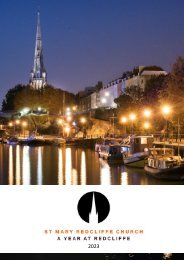You also want an ePaper? Increase the reach of your titles
YUMPU automatically turns print PDFs into web optimized ePapers that Google loves.
Winning Scheme<br />
presents compelling<br />
solution<br />
Purcell, the Bristol-based architectural<br />
practice, presented the winning<br />
scheme in the recent competition<br />
which sought conceptual ideas for<br />
the development of the church<br />
precinct in the coming years<br />
and which would form the<br />
basis of a Heritage Lottery<br />
bid to raise funds to<br />
realise the scheme.<br />
Dan Talkes, Senior<br />
Architect at Purcell,<br />
outlines the inspiration<br />
and thinking behind their<br />
ideas for this exciting scheme.<br />
In 1574, Elizabeth I declared St Mary Redcliffe to be ‘The Fairest,<br />
goodliest and most famous parish church in England’. To coincide<br />
with the 450th anniversary of this statement, the St Mary Redcliffe<br />
Project seeks to undo the post-war planning decisions that have<br />
isolated the church, to repair its context and to relocate the church<br />
at the physical, spiritual and social heart of its community.<br />
Purcell are delighted to have been selected to assist the church in<br />
realising this vision. As Dan Tyndall has said, ‘We searched across<br />
the globe but found our architects around the corner’. Indeed,<br />
working from studios in King Street, Bristol, we have a long-standing<br />
involvement in Redcliffe, members of our team having lived, gone<br />
to school and worshipped in the area. Two of our team, Rob Gregory<br />
and Dan Talkes, have also tutored architectural projects in Redcliffe,<br />
at Bath University and The Welsh School of Architecture in<br />
Cardiff, respectively, and Rob was also a key member of the Redcliffe<br />
Futures Group.<br />
We therefore bring to the project an intellectual understanding of<br />
the church’s historic importance and a personal understanding of<br />
both the particular challenges of Redcliffe and the unique potential<br />
of this project to repair not only the church’s physical context but<br />
also to embed it within the aims and aspirations of its community.<br />
Our approach is rooted in history. Through analysis, we peeled back<br />
the post-war layers to understand how radically the church’s setting<br />
has changed and particularly how the dual carriageways of Redcliffe<br />
Way and Redcliffe Hill have isolated the church, creating dual faultlines.<br />
Our concept seeks to repair these by creating new ‘stitches’:<br />
© Richard Carmen<br />
first an east-west stitch that connects the Redcliffe Caves, Redcliffe<br />
Wharf, the Quaker Burial Ground, the Hermitage, Chatterton<br />
House and, ultimately, Temple Meads, to reintegrate the church<br />
in its historic context: then, a north-south stitch that links the<br />
Redcliffe Children’s Centre, St Mary Redcliffe and Temple School,<br />
Somerset Square, The Ship Inn, Pump Lane and St Thomas Street<br />
to forge a new connection between the more affluent communities of<br />
north Redcliffe and the relative deprivation of south Redcliffe. These<br />
stitches consciously unite not on the church’s crossing, but rather on<br />
a new community garden generated to its north-side.<br />
Located on the exact footprint of the former north-side churchyard,<br />
and adopting the ‘lost’ historic alignments that became instrumental<br />
to the form of our proposals, this community garden reestablishes<br />
the church’s mediaeval enclosure. This was critical to our concept<br />
since, as residents of Redcliffe, we had all experienced just how<br />
experientially threatening it could be to access the church, its great<br />
beauty and near cathedral-like scale, whilst undeniably contributing<br />
to its significance, also presenting a potential barrier to its principal<br />
function as a parish church.<br />
However, during the competition process, we surrounded ourselves<br />
with historic images of Redcliffe and, from these, we noted how,<br />
until relatively recently, the church was seen not in toto, but rather<br />
through a series of tantalising, more human-scale encounters that<br />
had the potential to encourage more personal engagement.<br />
Indeed, our proposal is underpinned by the desire to increase the<br />
physical, social and spiritual accessibility of St Mary Redcliffe,<br />
4


















